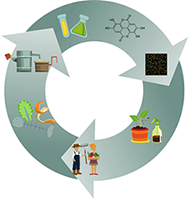Lin Xu and Danny Geelen
Department Plants and Crops, Ghent University, Coupure Links 653, B-9000 Ghent, Belgium
In modern agriculture, seeking eco-friendly ways to promote plant growth and enhance crop productivity is of priority. Biostimulants are a group of substances from natural origin that contribute to boosting plant yield and nutrient uptake, while reducing the dependency on chemical fertilizers. Developing biostimulants from by-products paves the path to waste recycling and reduction, generating benefits for growers, food industry, registration and distribution companies, as well as consumers. The criteria to select designated by-products for valorizing as biostimulant are: absence of pesticide residue, low cost of collection and storage, sufficient supply and synergy with other valorization paths. Over the years, projects on national and international levels such as NOSHAN, SUNNIVA and Bio2Bio have been initiated i) to explore valorization of by-products for food and agriculture industries; ii) to investigate mode of action of biostimulants from organic waste streams. Several classes of waste-derived biostimulants or raw organic material with biostimulant components were shown to be effective in agriculture and horticulture, including vermicompost, composted urban waste, sewage sludge, protein hydrolysate, and chitin/chitosan derivatives. As the global market for biostimulants continues to rise, it is expected that more research and development will expand the list of biostimulants from by-products. Global nutrient imbalance also requires biostimulant to be developed for targeted market. Here, we review examples of biostimulants derived from agricultural by-products and discuss why agricultural biomass is a particularly valuable source for the development of new agrochemical products.
doi: 10.3389/fpls.2018.01567
https://www.frontiersin.org/articles/10.3389/fpls.2018.01567/abstract
